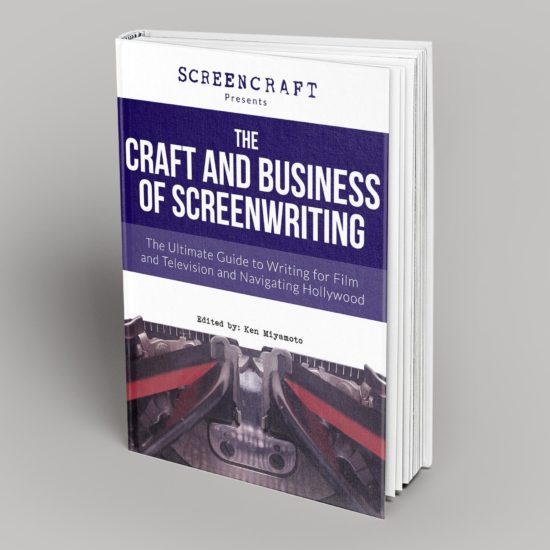Elevator Pitching: How to Grab Someone's Attention in 30 Seconds or Less

It’s not hard to give yourself a nervous breakdown when thinking about the word “pitch”. Lots of screenwriters let their imaginations take them to the absolute worst case scenarios: mirthless office meetings, the inability to come up with words — or even worse, the idea that you might talk way too long and lose what little interest there may have been.
Don’t worry, though. There’s a science and an art to the pitching process. One of the best ways to ensure you don’t deal with the disheartening realization that you’ve spoken too long (or not at all) is to formulate your pitch ahead of time. We’re not talking about a preparation slideshow that takes a half-hour to walk through. We’re talking about thirty seconds — an elevator pitch that gives you just enough time to catch someone’s attention if you do it just right.
So read closely, and get familiar!
Have a Snappy Title
You better not waste any time. You only have thirty seconds, remember?
Don’t ever forget to pitch the project with your title included. If you hate your working title, just give a few seconds of setup — let them know it’s a 90-minute exaggerated melodrama, a procedural, a dark 60-minute serial. Whatever it is, set the stage, and do it quickly — spend no more than a few seconds setting the expectation before moving on to something immediate and powerful, as you’ll see below.
The "Hard-Hitting Question"
This might be a bit of a misnomer, but it depends on your chosen approach: you can use a prolific statement, a small introduction to a strange world, or yes, even a hard-hitting question. Whatever it is, don’t wait for the answer — it’s part of the rhetoric.
Offer this question -- something like, “Ever wondered what really goes ‘bump’ in the night?”, or a statement that brings home a theme from your story, like “Some people will do anything to rid themselves of guilt — even something darker and nastier, as long as they can sleep at night.” The goal of this is to connect to an emotional or intellectual response in your audience. Whether it’s a passerby, your bestie, or an exec in an elevator (cliché though it might be), this is an important step.
Just make sure to introduce yourself first, or you might creep someone out.
Connect The Dots
Who’s the hard-hitting question about? What’s the world you’ve set up for us? Why share that thematic statement? You need to connect the dots between what you’ve just presented and the idea you have. If you’re talking about what really goes “bump” in the night — explore that further, by answering! If you’re talking about a person doing something dark and nasty to “clear their conscience”, tell us who they are!
This is where you introduce the Walter White, the Fleabag, the Sam and Dean of your story — and you explain in a few words their predicament or their world. Make sure that these dots include the beginnings of an actual story: "a woman in the midst of self-discovery," "a group of misfits trying to save the world," all with some personal flair. Identify a character, and identify a problem — and connect them to that thematic statement, that hard-hitting question that’s meant to make them think.
Keep Them Hanging
It’s the rule of any good story — or any good start to a story — no matter how long. A pitch is no different. Always keep your audience wanting more.
You’ve identified the project, provided a hard-hitting question to make them think or feel, and you’ve connected that question with a character and a problem. Now, it’s time to make that problem a cliffhanger: if the problem’s big enough, it may speak for itself, but in some cases, it may make more sense to build on it with a final thought, a question, or a teaser action that tells your audience the direction you’re going in, and the tone you’re shooting for.
For someone that’s living a double life, set up a question like, “Will his family discover his secret?” Then, think about genre, and make it a part of your cliffhanger. For example, if a group goes off in search of their travel companion in a dark, scary, dank environment, you may add a little flavor to the original question: “Will they find their lost companion… before something finds them?”
Keep Pitching!
Confidence is a powerful tool in a pitch meeting -- even an elevator pitch -- and feeling well-prepared can boost yours big time. With that in mind, you have to keep practicing.
Try recording yourself first, with the tips above to guide you, and make it under thirty seconds. Then, when you’ve perfected the pace of your pitch, start to share your pitch with others, with anyone who will listen, even if it's virtually over Zoom. (A lot of pitches are virtual now anyway.) Work on your delivery, and take note of what piques someone’s interest. If you’ve got them asking more questions, you know you’re doing it right — so keep at it!
Read More: 7 Signs You Have a Good Story Idea
 David Wayne Young is an independent film producer and screenwriter with years of experience in story analysis, even providing coverage for multiple international screenwriting competitions. David's obsessions include weird fiction and cosmic horror, and he's formally trained in the art of tasting and preparing gourmet coffee in various worldly traditions, from Turkish coffee to hand-tamped espresso — all enjoyed while writing, of course.
David Wayne Young is an independent film producer and screenwriter with years of experience in story analysis, even providing coverage for multiple international screenwriting competitions. David's obsessions include weird fiction and cosmic horror, and he's formally trained in the art of tasting and preparing gourmet coffee in various worldly traditions, from Turkish coffee to hand-tamped espresso — all enjoyed while writing, of course.
Tags
Get Our Screenwriting Newsletter!
Get weekly writing inspiration delivered to your inbox - including industry news, popular articles, and more!




























